Sustainability used to be someone else’s responsibility. A line on a strategy slide. A checkbox in procurement. Maybe a pilot project that faded quietly into operational debt.
But today, it’s sitting squarely in the hands of infrastructure and operations leaders. And it’s no longer optional. Rising energy costs are pushing sustainable IT solutions into the spotlight. So are tightening ESG regulations and increasing pressure from executive boards.
And what was once a brand-level commitment is now a technical, measurable obligation. Infrastructure teams are being asked to deliver performance, resilience, and compliance without compromising on environmental impact. The shift is no longer theoretical.
Carbon emissions from data centres and enterprise workloads are being scrutinised at the policy level. According to the International Energy Agency, data centres consumed approximately 415 terawatt-hours of electricity in 2024 — around 1.5% of global power. And that figure is expected to more than double by 2030.
Legacy hardware footprints are raising risk flags in vendor audits. And AI's infrastructure load is already testing capacity, cost ceilings, and carbon budgets in equal measure.
For enterprise leaders, the question is no longer whether to act. It’s where to start, what to prioritise, and how to ensure infrastructure sustainability delivers real returns. The opportunity is clear. So is the pressure.
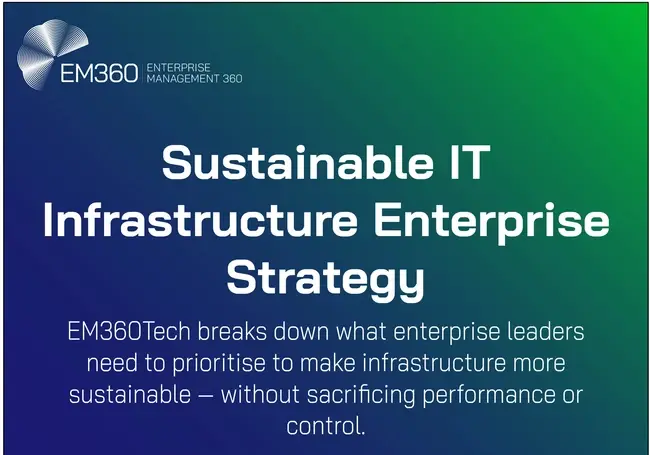
Why Sustainable Infrastructure Has Moved to the Forefront
Infrastructure leaders didn’t sign up to become environmental strategists. Yet here they are. Facing escalating pressure to reduce their organisation’s carbon footprint — without sacrificing uptime, security, or performance.
This shift hasn’t happened gradually. It’s the result of multiple forces converging at speed. Soaring energy prices have made inefficiency a financial liability. The infrastructure load created by AI and large-scale analytics is outpacing power capacity in key regions.
Google, for example, reported a 27% year-on-year increase in electricity use. Which is a direct consequence of rising AI and data centre demand. And emissions from digital operations are now on the radar of regulators, auditors, and investors alike.
Boards are asking harder questions. Where are the inefficiencies hiding? What’s our CO₂ exposure from infrastructure operations? Are we compliant with evolving ESG disclosure requirements?
We now expect infrastructure teams, who were once outside that conversation, to lead it.
The debate isn’t just about long-term sustainability goals. It’s about short-term risk. Infrastructure strategies that ignore environmental impact are no longer invisible. They’re starting to show up in audit findings, contract negotiations, and cost overrun reports.
What used to be dismissed as a “green” concern is now an operational one. And for many, it’s become the proving ground for how seriously the business takes its digital transformation agenda.

Infrastructure Sustainability: What It Actually Means
Not everything with a carbon label counts as infrastructure sustainability. Corporate messaging often dilutes the term by treating it as synonymous with green software, paperless policies, or net-zero branding.
But for infrastructure teams, sustainability starts with what they build, power, connect, and maintain. Sustainable IT in this context refers to the environmental impact of the physical estate that underpins digital operations.
That includes the servers inside your racks. The energy that keeps them running. The networks they rely on. And the systems that manage their lifecycle.
It’s about reducing energy consumption across compute, storage, and network layers. It’s about extending the life of hardware without compromising performance. It’s about managing electronic waste before it accumulates in budget lines or landfills.
And it’s about choosing vendors, facilities, and cloud providers that can prove their efficiency credentials. Not just claim them.
What to Prioritise First: High-Impact Areas for Infrastructure Leaders
Sustainability can’t be tackled everywhere at once. And for infrastructure teams already stretched by performance demands, compliance updates, and resource constraints, prioritisation is everything. These are the areas where action delivers the most immediate value — financially, operationally, and environmentally.
Energy optimisation across compute, storage, and network
Energy efficiency starts at the infrastructure core. In most enterprise environments, compute workloads account for the largest share of energy use, followed by storage and networking. But the savings aren’t just in hardware swaps. They’re in how that hardware is configured, managed, and placed.
Power Usage Effectiveness (PUE) is still the benchmark for data centre efficiency. But Carbon Usage Effectiveness (CUE) and Water Usage Effectiveness (WUE) are gaining traction in regulatory and ESG reporting.
These metrics translate abstract goals into operational signals. If infrastructure leaders don’t know these numbers, their teams are working blind. Small changes add up.
Virtualisation and workload consolidation alone can cut energy use by up to 29 %. Server power management adds another 9 % in savings on top of that. Smart workload placement across time zones and cloud regions can reduce the carbon impact of operations without compromising latency.
Power over Ethernet (PoE) provisioning and automated port deactivation can significantly reduce idle energy waste across the network layer.
Cooling design is still one of the most overlooked drivers of energy use across facilities. Especially when it comes to containment strategies and thermal zoning.
Lifecycle and hardware refresh strategies
There’s no single answer to when infrastructure should be replaced, extended, or repurposed. But sustainability-driven decisions require more than cost-based refresh cycles. Leaders need to understand the total lifecycle impact — not just the upfront energy profile of new equipment.
In many cases, a certified refurbished server with high-efficiency ratings may outperform a new unit. And not just in cost, but also in carbon intensity and electronic waste. Upcycling and asset repurposing have gained ground, particularly with organisations moving to modular or hybrid designs.
But they only work with clear inventory visibility and robust IT asset lifecycle management. Vendor certifications matter here. So does integration with asset tracking tools and secure disposal workflows.
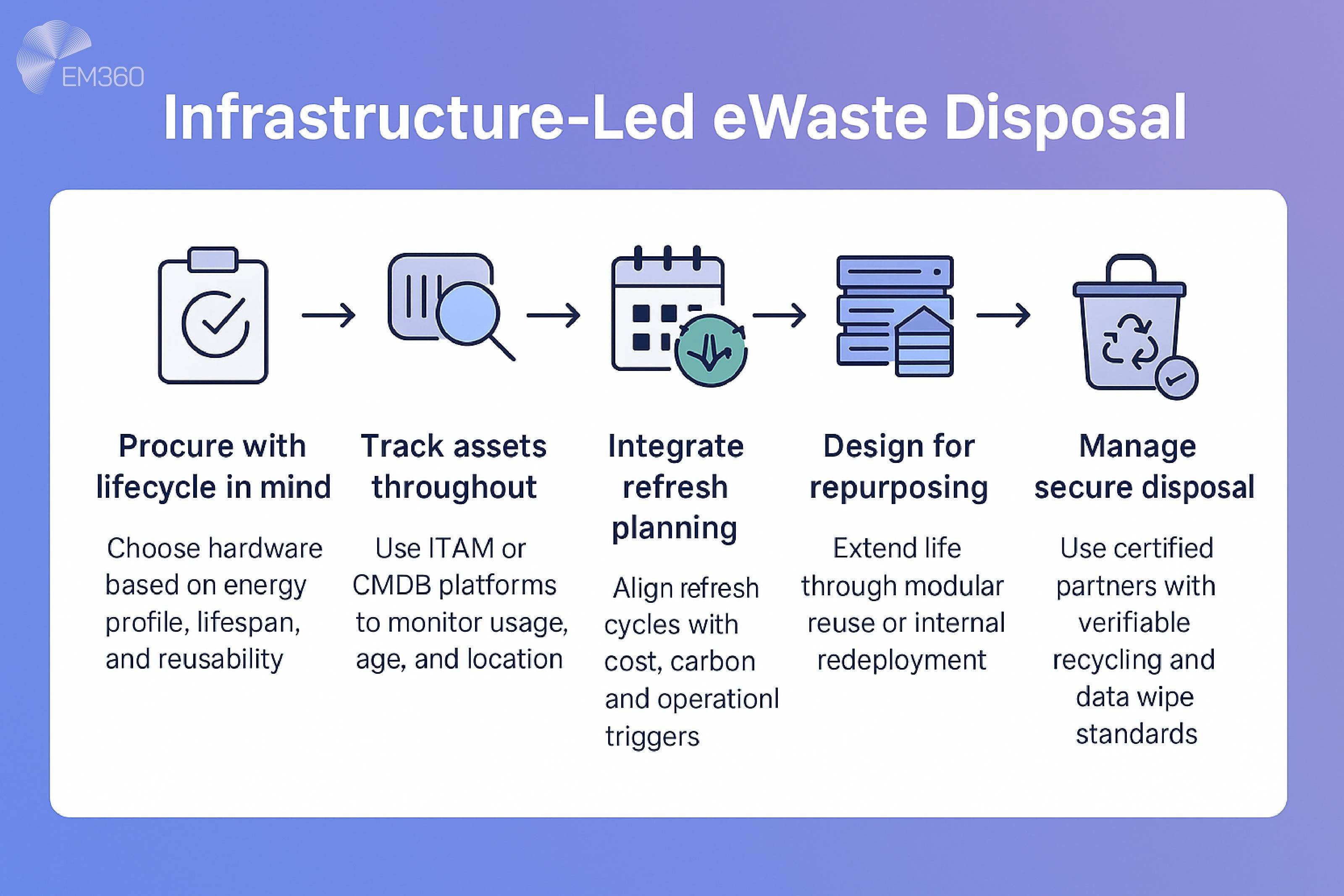
Infrastructure leaders should treat waste management as an infrastructure function, not a downstream process. When it reaches procurement, the opportunity to optimize has already passed.
Sustainable vendor selection and cloud design
Vendor sustainability claims are easy to make and hard to verify. Infrastructure leaders need frameworks, not promises.
That means requesting carbon disclosure reports. Asking for regional energy mix breakdowns. And evaluating cloud providers based on how workloads are placed and powered.
Carbon-aware scheduling is gaining traction in hyperscale environments, but it’s not exclusive to hyperscalers. Tools like GreenScale and open-source orchestration models give teams more control. They allow organisations to shift workloads based on carbon intensity, grid availability, or policy requirements.
Cloud-region matching — where workloads are placed in lower-carbon regions — is one of the most underused tactics available. The impact of these decisions is tangible. A Microsoft study found that switching from traditional enterprise data centres to the Microsoft Cloud improved energy efficiency by 22 to 93 per cent across core services.
When factoring in their zero-carbon electricity purchases, emissions savings reached as high as 98 per cent. Cloud, hybrid, and modular infrastructure all come with sustainability trade-offs. Cloud delivers immediate energy reductions if properly configured but can create visibility gaps in Scope 3 reporting.
Modular builds allow for precision deployment and contain energy use but may require a higher upfront design cost. Hybrid environments offer flexibility but demand discipline in orchestration and lifecycle governance.
Frameworks, Metrics, and Models That Matter
Infrastructure sustainability is only meaningful if it can be measured, monitored, and mapped to strategic outcomes. Most teams aren’t short on intent. They’re short on visibility, consistency, and language that connects environmental performance to infrastructure decision-making.
These are the frameworks and metrics that make sustainability operational. They turn vague commitments into concrete action plans. And give infrastructure leaders the tools they need to lead with credibility.
Measure what matters: PUE, WUE, CUE, and Scope 1–3
The first step to sustainable infrastructure is knowing where the energy goes. Power Usage Effectiveness (PUE) remains the go-to metric for data centre efficiency. It compares total facility power to IT equipment power. But PUE alone doesn’t give the full picture.
Carbon Usage Effectiveness (CUE) factors in the carbon footprint of the energy itself. That’s essential when sourcing from mixed grids. Water Usage Effectiveness (WUE) brings in another critical variable. Especially as water conservation becomes a shared concern across data centre regions.
The scale of the impact is already significant. In the United States alone, data centres consumed an estimated 176 terawatt-hours of electricity in 2023. That’s roughly 4.4 % of total national usage. Projections suggest that figure could rise to between 6.7 and 12% by 2028.
Beyond the facility, enterprise leaders need to understand Scope 1 (direct), Scope 2 (purchased energy), and Scope 3 (value chain) emissions. Scope 3 is especially thorny. It includes emissions from vendor operations. Cloud services.
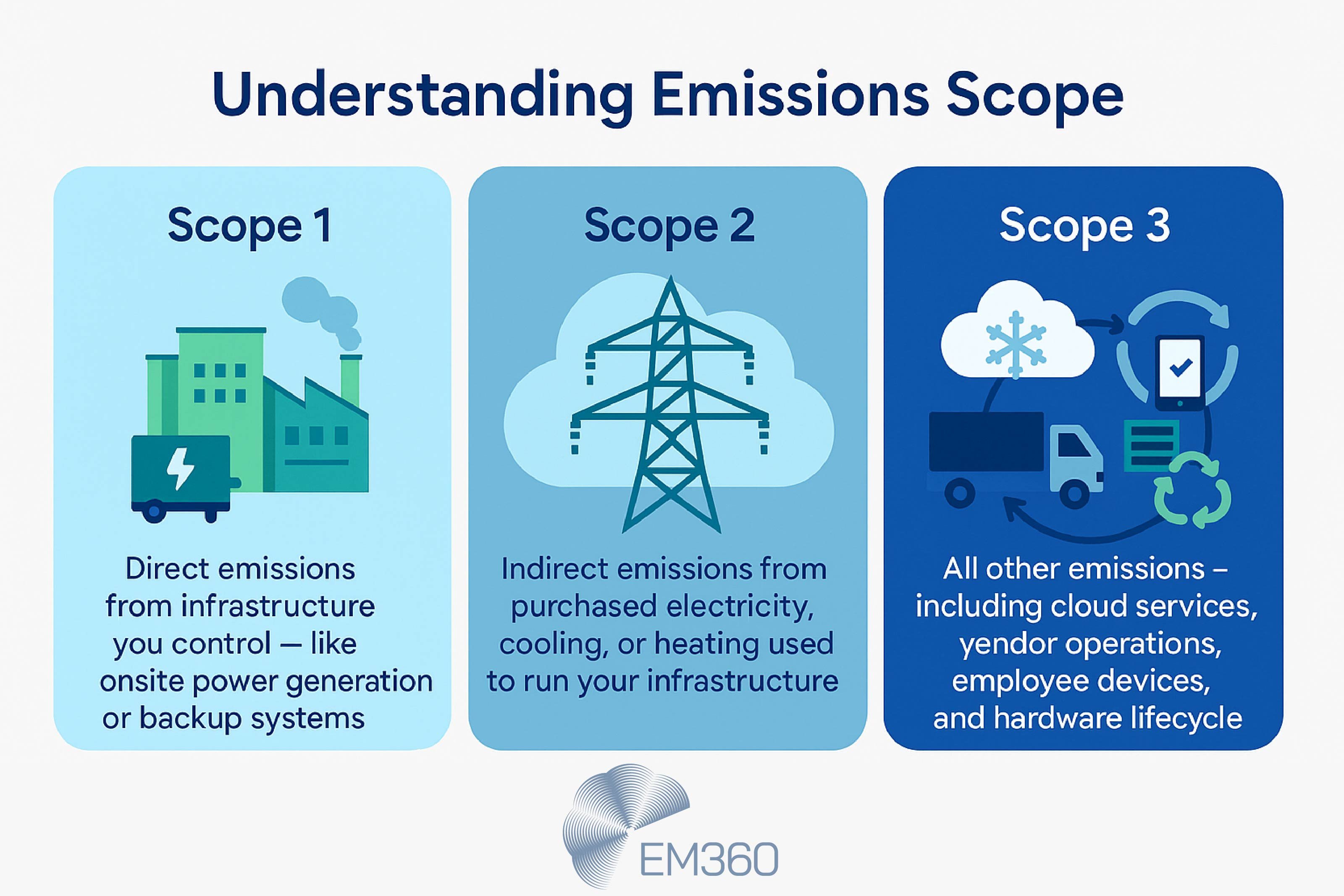
And end-of-life equipment — often the largest and least visible category. But regulators are tightening expectations, and investors are asking harder questions. Teams that can’t map their metrics will struggle to defend their strategies.
These metrics aren’t just for ESG reporting. They influence cost forecasts, vendor negotiations, and board-level infrastructure risk assessments. If sustainability isn’t tracked with the same rigour as uptime, it won’t survive budget season.
Adopt proven frameworks: FAST‑Infra, SuRe, UN Principles
Decision frameworks give sustainability efforts structure and credibility. They help infrastructure leaders evaluate options, justify spending, and stay aligned with global standards.
The FAST‑Infra label consolidates over 50 global guidelines into four core pillars: Environmental, Adaptation and Resilience, Social, and Governance. It was designed specifically for large-scale infrastructure projects and is increasingly recognised by public and private capital.
SuRe (Standard for Sustainable and Resilient Infrastructure) focuses on lifecycle impact and stakeholder engagement. That makes it especially useful for infrastructure teams navigating multi-vendor ecosystems.
The UN’s Good Practice Principles for Sustainable Infrastructure reinforce these models. They emphasise upstream planning and cross-functional governance.These frameworks aren’t just for public sector projects.
They're being used by private enterprises to validate procurement, standardise reporting, and reduce ESG-related compliance exposure. For infrastructure leaders, they offer a clear path to both operational alignment and external accountability.
Benchmark your progress: Infrastructure sustainability maturity model
Knowing where you are is just as important as knowing where you want to go. A sustainability maturity model helps teams self-assess, align expectations, and communicate progress in practical terms.
The typical journey includes five stages:
- Ad hoc — Basic tracking, no central accountability
- Reactive — Compliance-driven initiatives, limited visibility
- Structured — KPIs defined, frameworks adopted, reporting in place
- Integrated — Real-time telemetry, lifecycle planning, cross-team ownership
- Orchestrated — Predictive, carbon-aware systems embedded in operations and procurement
This kind of model is more than an internal roadmap. It becomes a tool for board communication, vendor strategy, and executive buy-in. Teams that can show movement across these stages are better positioned to secure investment. To lead cross-functional efforts.
And to deliver on sustainability goals without falling into greenwashing.
Make it visible: Dashboards, telemetry, and observability
Sustainability strategies collapse when they live in static reports. To drive real change, metrics need to be embedded into the systems teams use to manage workloads, track performance, and make decisions.
Integrated observability tools now offer sustainability modules alongside performance and security metrics. These platforms can show real-time carbon intensity by workload, flag high-emission operations, and help optimise resource use across on-prem and cloud environments.
Dashboards that combine telemetry, emissions monitoring, and cost-performance metrics give teams the clarity they need to course-correct without waiting for a quarterly review. They also create the conditions for real accountability.
When infrastructure sustainability is visible, it becomes operational. When it’s buried in PDFs, it stays theoretical.
Risk, ROI, and Regulation: Why It Pays Off
Sustainability is no longer a side initiative. It is a lever for cost control, operational resilience, and regulatory readiness — and infrastructure leaders are being asked to pull it.
Reduce cost through smarter infrastructure
The most immediate return comes from energy. Efficient hardware, intelligent workload placement, and modernised cooling systems can reduce power consumption at every layer of the stack.
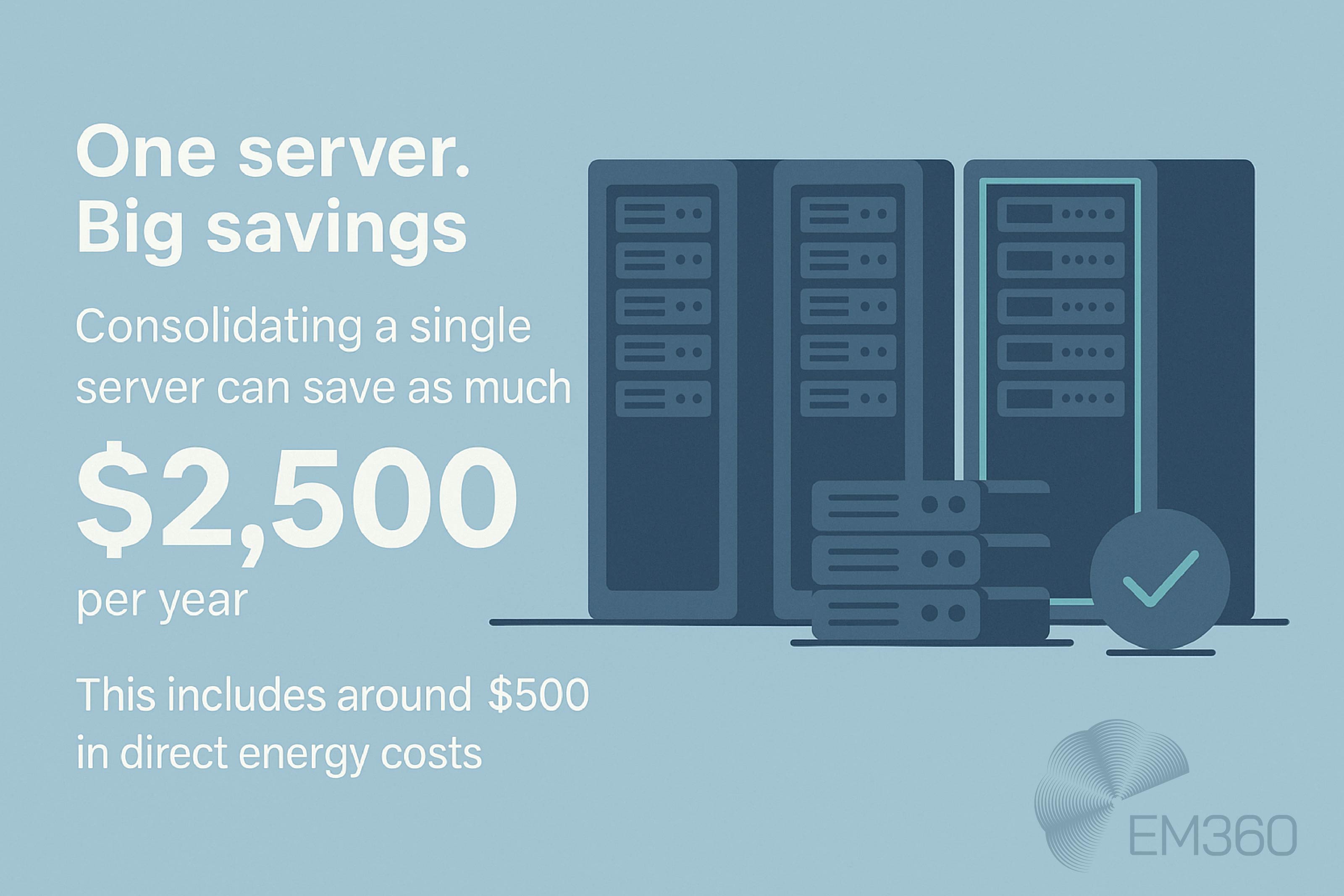
Migrating workloads to right-sized cloud environments can cut both energy consumption and overhead. Even micro-optimisations — idle port shutdown, automated provisioning, thermal zoning — drive meaningful savings at scale.
Consolidating a single server can save approximately $2,500 per year, including around $500 in direct energy costs. At enterprise scale, those savings multiply quickly — turning small infrastructure wins into significant budget relief.
In most enterprise environments, infrastructure is one of the top five contributors to energy spend. That makes sustainable IT practices not just environmentally responsible, but also financially strategic.
Build resilience into every layer
Sustainability isn't just about savings. It’s about systems that can adapt, scale, and endure. Infrastructure that consumes less power and generates less heat is easier to maintain, less vulnerable to outages, and more capable of supporting AI-driven workloads without blowing past cost or capacity ceilings.
Efficiency has become a prerequisite for growth. Unoptimised infrastructure will limit scale before it reduces carbon emissions. And as demand from generative AI, high-density analytics, and edge expansion spikes, this limitation becomes a real business risk.
Stay ahead of regulation and ESG scrutiny
Infrastructure is already showing up in ESG compliance audits. The EU’s Corporate Sustainability Reporting Directive (CSRD) and similar frameworks are forcing organisations to disclose detailed emissions data across Scope 1, 2, and 3.
That includes the energy your infrastructure uses, the carbon profile of your vendors, and the impact of hardware lifecycle decisions. Teams that cannot surface this data will find themselves excluded from procurement conversations and investor pipelines.
Non-compliance carries legal and reputational risks. But proactive infrastructure reporting builds trust, enables better vendor relationships, and reduces friction across the ESG stack. Sustainability targets only work when infrastructure can support them.
When it does, infrastructure becomes a strategic asset — not just a line item to defend.
Build or Buy: Planning Your Infrastructure Sustainability Journey
Not every team needs to build from scratch. And not every leader needs to solve sustainability with a sweeping overhaul. The most effective infrastructure strategies are the ones that fit — with your visibility, your architecture, and your current stage of maturity.
The question isn’t whether to act. It’s how.
Optimise from within
Internal optimisation is often the fastest path to impact. It suits organisations with strong observability, established asset management, and teams that already own configurations and workload placements.
This path focuses on tuning what you already have. That includes energy-efficient design, workload scheduling, idle port control, and power-aware provisioning. It also means using existing infrastructure monitoring tools to track power consumption and emissions over time.
For mature teams, these optimisations can deliver measurable gains without the cost or complexity of full redesigns.
Partner for scale and speed
External enablement makes sense when internal resources are limited or timelines are tight. This path depends on cloud providers, managed service partners, and procurement frameworks that are built around sustainability goals.
Success here relies on clarity. Teams need to embed sustainability requirements into SLAs, contract language, and vendor selection criteria. That means asking for carbon disclosures, reviewing energy mix profiles, and demanding transparency on workload placement.
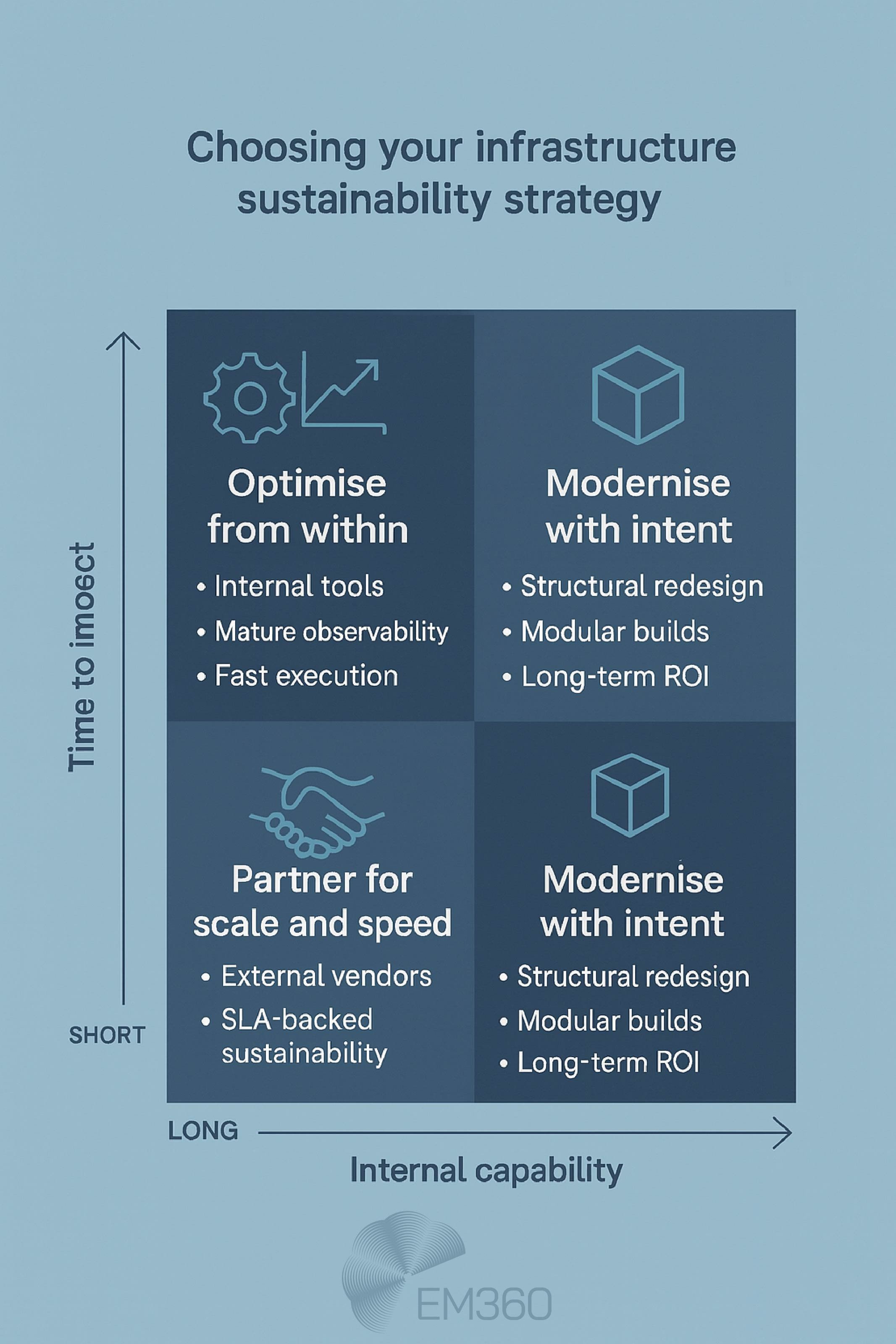
Cloud platforms that support carbon-aware scheduling or region-based emission modelling can accelerate impact — but only if they’re configured and monitored with intent.
Modernise with intent
Some organisations are ready for structural change. Staged modernisation involves refreshing legacy systems with energy efficiency in mind, adopting modular builds, or redesigning for hybrid environments.
This path is ideal when broader transformation is already on the table. It offers long-term control and operational precision but comes with heavier planning, higher capital costs, and longer rollout timelines.
Observability is critical here. Without real-time visibility into power use, cooling efficiency, and hardware lifecycle, modernisation efforts risk falling short of their sustainability promise.
Ask the right questions before you act
Choosing the right path starts with asking the right questions — not just about your goals, but about how much control, visibility, and influence your team actually has.
Visibility and measurement
Sustainability decisions require data. Accurate, real-time insight into how infrastructure consumes energy and generates emissions is essential; without it, even the best intentions fall flat. These questions help clarify what you can see — and what you can’t.
- Do we have real-time visibility into energy use across workloads, sites, or systems?
- Can we map carbon emissions by business function, region, or cloud provider?
- Are we tracking key infrastructure metrics like PUE, CUE, and Scope 2 emissions?
- Are those metrics used beyond compliance — to influence design or operations?
Operational capability
Seeing the problem isn’t enough. Infrastructure teams need the mandate and mechanisms to act. This set of questions helps assess whether sustainability efforts can be executed internally or whether external support will be needed.
- Do our teams have the authority to adjust workload placement or power configurations?
- Is our observability stack integrated with sustainability metrics or energy thresholds?
- Can we automate high-impact actions like idle port shutdown or instance right-sizing?
- Are efficiency and optimisation targets built into day-to-day infrastructure workflows?
Procurement and strategic alignment
Sustainability isn’t just a technical problem. It’s a strategic one. That means it needs to show up in procurement, vendor management, and infrastructure planning — not just in ESG statements.
These questions reveal if sustainability is a core component or an add- on.
- Are sustainability metrics included in our RFPs, SLAs, and vendor scorecards?
- Do we evaluate partners based on emissions transparency, energy sourcing, and lifecycle impact?
- Is infrastructure sustainability reflected in our broader IT or digital transformation strategy?
- Do we have a clear governance owner for infrastructure-level sustainability performance?
You don’t need perfect answers to move forward. But you do need an honest view of where your team stands — and where you'll need support.
Final Thoughts: Sustainability Is the New Stability
Sustainability is no longer a side stream to infrastructure strategy. It is the filter through which performance, cost, compliance, and resilience are being re-evaluated. Leaders who treat it as a compliance task will miss the opportunity to redesign for efficiency and scale.
Leaders who treat it as a foundation will build infrastructure that lasts. The pressure to act is real. But so is the potential. Energy-efficient hardware, carbon-aware orchestration, and lifecycle-led design are not future features — they are core components of a modern infrastructure optimisation strategy.
Every team will take a different path. What matters is that the path is intentional. That it starts with clear visibility, aligns with operational capacity, and delivers measurable value across the board.
If you're ready to move from intent to impact, EM360Tech has the frameworks, expert insights, and diagnostics to help you lead with confidence.







Comments ( 0 )